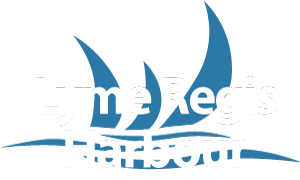Annual Dredging Works
14 February 2024
Dredging Works
Please note that the dredger will be arriving soon to commence annual dredging of the Lyme Regis harbour approach and summer pontoons. We are starting early this year, hoping that the stormy weather is behind us but in time to finish the works before the tourist season begins in earnest at Easter. The work will be done in two phases, first the dredging and then the beach work with construction plant. To avoid any danger to members of the public, during the beach work phase, we will be closing off the beach front with Heras fencing as indicated by a red dotted line in Figure 1 below. The fence should be erected on 6 March and removed by 19 March. We are making every effort to execute the work at a time that will cause least disruption and trust that they will not cause you any undue inconvenience.
Dates - The dredging equipment will arrive at West Bay on 12 February, offloaded and then towed to Lyme Regis where dredging will start a few days later. Dredging at Lyme Regis must be completed by 5 March 2024. They will then move back to West Bay where dredging will restart and be completed by 28 March 2024. At Lyme Regis, the beach will be closed on 6 March, when the dredging operation is completed, and the construction plant will be mobilised to complete the process of collecting sand and putting it back onto Front Beach. This work is set to coincide with spring low tides. The beach will be opened again on 19 March 2024.
Harbours - Our harbours provide safe mooring and launching facilities for small boats and are important refuges along the Dorset coast for any vessels at sea that may be in difficulties. Harbours can suffer from sediment deposits either from rivers or from the natural action of waves on beaches. To maintain the safe depths for the navigational channels and water ways this sediment is removed on a regular basis. This process is called dredging. Dredging is planned for West Bay and Lyme Regis in February and March this year.
Dredging - This can be done by boat or using earthmoving equipment at low tide. All equipment has biosecurity measures in place to make sure they are free of invasive and non-native species. They also use biodegradable fuels and oils to lessen the release of harmful chemicals into the marine environment. Every year the accumulated sediment that has deposited over the last twelve months is removed from the navigational channels and used to build up the local beaches. The area being dredged is a very busy area and doesn’t contain any habitats of note for local marine plants and animals. We are monitoring nearby reefs as part of the dredging regime to make sure our actions do not damage locally more sensitive habitats.
The beaches - When appropriate, beaches will be fenced off for safety due to the machinery being used. The colour of the dredged sand is often darker in colour due to the lack of exposure to oxygen on the seabed. Once exposed to the air it returns to the normal colour we are used to. But to make sure the beauty of our beaches isn’t affected we place this dredged sand beneath a layer of the sand that is already there, which we have moved aside for this purpose.
Water quality - Last year extensive testing of the dredging sediment was carried out at Lyme Regis. These tests showed that there was no Escherichia Coli (e-coli) or Intestinal Enterococci released into the water because of the dredging and excavating activity. At West Bay the dredging is being carried out under an MMO licence and in accordance with licencing requirements, the sediment was tested and found to be safe for discharge in the marine environment. The colour of the sea will change due to the disruption of the seabed with sand particles suspended in the water. Swimming in the discoloured water is discouraged due to the potential for allergic reactions due to these particles.





